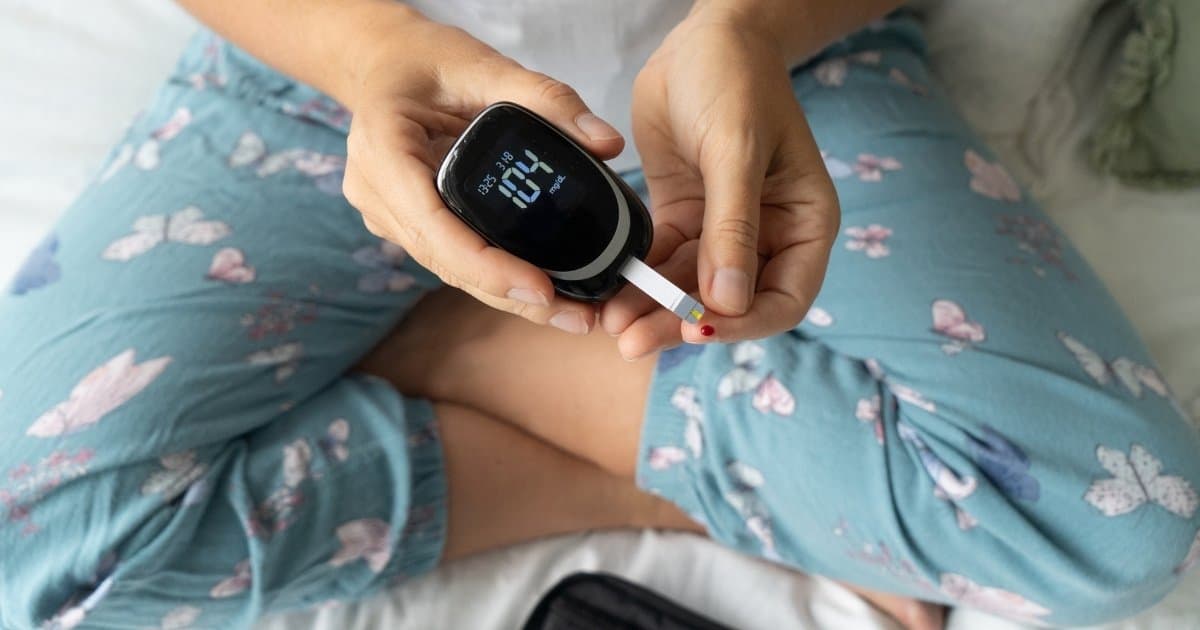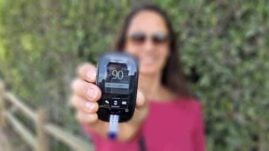If you suddenly find yourself faced with a prediabetes diagnosis, it can be very sudden and very scary.
This common condition affects nearly 90 million Americans, and more people are being diagnosed every day.
So what do you do when you’re faced with a prediabetes diagnosis and you want to reverse your condition before it develops into type 2 diabetes?
And exactly how long can that process take? Is it even possible?
This article will outline the ins and outs of reversing prediabetes and everything you need to know.

What is prediabetes?
Prediabetes is a condition that means your blood glucose levels are elevated, but not elevated to the extent that you would be diagnosed with diabetes mellitus.
Prediabetes is usually the result of chronic insulin resistance, and with fasting blood glucose levels between 100-125 mg/dL.
People without diabetes have a fasting glucose of below 99 mg/dL, and someone with type 1 or type 2 diabetes would normally see a fasting blood sugar level of above 125 mg/dL.
Without intervention, around 70% of people who live with prediabetes will go on to develop type 2 diabetes.
Who is at higher risk for prediabetes?
While anyone can develop prediabetes, there are several factors that will increase your risk of developing the condition.
Ask your doctor for a glucose test, if you have any of the following risk factors and feel that you may be developing prediabetes:
- You have a direct relative who has type 2 diabetes (sibling or parent)
- You are 45 years or older
- You are African-American, Hispanic, Native-American, Pacific Islander, or Asian-American
- You suffer from Polycystic Ovary Syndrome (PCOS)
- You have Cushing’s Syndrome or Acromegaly
- You suffer from sleep apnea
- You previously had gestational diabetes while pregnant
- You take steroids for a health condition, are on certain antipsychotic or HIV medications
Additionally, the following risk factors you can control, and are able to modify to lower your risk of prediabetes:
- You are overweight or obese
- You eat a poor diet, full of saturated fats and added sugars
- You live a sedentary lifestyle and get no regular exercise
- You suffer from high blood pressure or high cholesterol, and they’re not well-controlled
- You suffer from metabolic syndrome, which is a combination of hypertension, high cholesterol levels, and a large waist measurement
- You smoke cigarettes
- You drink alcohol in excess
Quitting smoking, increasing your physical activity levels, losing excess weight, and improving your diet can help lower your risk for prediabetes.
Keep in mind that prediabetes, since glucose levels are not extremely elevated and most people are producing at least a small amount of insulin, can sometimes be asymptomatic, while still being harmful to your health.
Studies show that more than 84% of people who have prediabetes don’t even know they have it! It’s important to go to the doctor regularly to get checked!
If you feel that you may be at risk, take the risk test, provided by The Centers for Disease Control and Prevention (CDC).
You can learn more about when and how to test for prediabetes in our guide How Often Should You Test For Prediabetes?
What do you do if you get diagnosed with prediabetes?
If you get diagnosed with prediabetes, don’t panic. Work with your doctor to develop a strategy and health plan that will work for you, based on your goals, needs, and lifestyle.
Even making moderate lifestyle changes can prevent the onset of type 2 diabetes, and the host of complications that the condition can bring.
According to the CDC, losing only between 5-7% of your body weight can prevent the onset of type 2 diabetes.
They recommend being physically active for about 30 minutes per day, most days of the week (aim for at least 150 minutes per week).
Can prediabetes be reversed?
Yes! Before prediabetes develops into type 2 diabetes, it can absolutely be reversed.
To help people reverse prediabetes and prevent the onset of type 2 diabetes, the National Diabetes Prevention Program (NDPP) is an accredited program recognized by the CDC that focuses on healthy eating and physical activity.
In a study, participants of the NDPP cut their risk of developing type 2 diabetes by 58% when completing the program (and 71% for people over 60 years old!).
There are accredited programs in every state, and most insurance plans cover the cost of participating, including some state Medicaid programs and Medicare.
Some additional lifestyle changes that can reverse prediabetes include:
- Swapping out sugar-sweetened beverages for water
- Cut out processed carbohydrates and foods with added sugar
- Eat a lower carbohydrate diet, with plenty of fruits and vegetables
- Reduce your overall caloric intake
- Increasing your protein intake at all meals
- Recruit the help of a dietician to better tweak your diet and for healthy meal ideas
- Limit your alcohol intake
- Get adequate sleep (between 7-9 hours for most people)
- Take all medications as prescribed
- Test your blood sugar often, with an at-home glucometer (available at any pharmacy)
- Manage any other health conditions you have, including hypertension or high cholesterol)
- If you smoke cigarettes, quit
- Manage your stress levels with deep breathing, meditation, yoga, or journaling
- Seek support from family, friends, or a support group
- Maintain a healthy weight, and lose any excess body weight
“Ever since I took the steps to make changes in my diet and lifestyle, my blood sugar levels have been in range and my A1c has been in the normal range for seven years straight!”
Venus Jones (read Venus’ story of reversing prediabetes)
How long does it take to reverse prediabetes?
This all depends upon the person, but most researchers would say the window of opportunity to prevent or slow the progression of prediabetes to type 2 diabetes is two to six years.
After that amount of time, most people will develop type 2 diabetes. However, for many people, it does not take nearly that long to reverse the condition.
Since the emphasis for reversing prediabetes depends upon weight loss and increasing your physical activity levels, it usually will depend upon how long it will take you to lose between 5-7% of your body weight.
For example, if you weigh 250 lbs, according to the CDC, to lower your risk of developing type 2 diabetes (and thus “reversing” prediabetes, if you are diagnosed with the condition), you would need to lose between 12.5-17.5 lbs at a minimum.
One pound of body fat is equivalent to 3,500 calories. If you cut out 500 calories per day (and increase your physical activity by including more mild and moderate exercise, like walking and swimming), you could potentially lose 1 pound per week ( 500 calories x 7 days = 3,500 calories).
Not all calories are the same, however, and you will definitely want to work with a registered dietitian or nutritionist to develop a healthy, sustainable eating plan that will work for you and your weight loss goals.
Your weight loss goal of reaching between 232.5 lbs-237.5 lbs could take you between 3 to 5 months, without crash dieting or any setbacks along the way.
However, if you already have a prediabetes diagnosis, you may be dealing with insulin resistance, which can make losing weight harder.
You will need to work with your doctor to see if they recommend any additional medications, such as Metformin or Ozempic, that can assist you in your weight loss journey.
Conclusions
Reversing prediabetes will depend on you making healthy lifestyle choices, improving your diet, and increasing the amount of physical activity you do per week.
The Centers for Disease Control and Prevention (CDC) recommends that to reverse prediabetes, people need to focus on losing between 5-7% of their body weight and increasing physical activity, such as walking, biking, or swimming.
Reversing prediabetes takes time, and everyone is different. Some people may only need to lose a few pounds to lower their risk of developing type 2 diabetes, while other people will need to lose substantially more weight to decrease their risk.
Losing weight and reversing prediabetes can take anywhere from a few weeks, to a few months, to a few years, but the window of time to reverse prediabetes after a diagnosis is between 2-6 years – so you have time!
People with prediabetes are already dealing with existing insulin resistance that may make weight loss and reversing prediabetes even harder.
Without intervention, most people who have prediabetes will develop type 2 diabetes within 10 years.
Work with your doctor and a registered dietitian and/or nutritionist who can create a healthy and sustainable eating and exercise plan that can help you take charge of your health and reverse your prediabetes before it develops into type 2 diabetes, which is not reversible.




Maria R Vega
My name is Rita i was just dignosed with pre diabetes im so confused about what to eat i never been sick of anything and this situation has be so confused.
Christel Oerum
A new diabetes diagnosis can be very overwhelming and the amount of contradicting information doesn’t make it easier. I’d recommend you ask your doctor for a referral to a diabetes educator and/or a registered dietitian who understands diabetes. They can help you with what works for you and your body.
But it’s important to know that a diabetes diagnosis doesn’t mean that there are things you can’t eat, but rather that you might choose to eat less of some things or decide that for you it’s easier to cut out
Alison
I have just come from a dr appt, the third check of my blood since being diagnosed with prediabetes about a year ago. Im frustrated. I went to see a nutritionist, started a rigorous exercise regime and changed my diet. Insurance refused to pay for the nutritionist referral so i ended up with an 800 dollar bill, i have lost 13 lbs but my numbers dont budge. In addition, i know have some serious arthritis knee issues, keeping me from exercising. Today my doctor told me that ozempic or weygovy is not my answer because it has not been approced by the fda to have any affect on prediabetes. According to charts im obese, my doctor says he is fine with my weight but that the only answer i have is metformin. But isnt this something ill be on the rest of my life? He agreed to let me try the ozempic first but warned me that insurance doesn’t cover. I mean, my husband and I dont meet medicare standards yet but pay out over 2000 a month in insurance with a 7000 deductible. I was referred to physical therapy for knee strength too- not covered. Honestly. Do you have any advice to get ozempic or weygovy at a reasonable price!? I feel totally defeated
Christel Oerum
Metformin isn’t something you’d have to be on forever. It is however much more affordable than Ozempic. Since you have private insurance, look into using the copay card to help you cover the costs (Here: https://www.ozempic.com/savings-and-resources/save-on-ozempic.html)
Jay
Like much information on prediabetes this concentrates on overweight people and of course I realise they are in the majority. But I am lean and at best get tokenistic references to not all people being overweight. I have stage 3 COPD and cannot afford to lose weight. My diet is near perfect with no sugar or processed carbs, ie cake, biscuits, pastry etc. Just fish chicken eggs occasional beans with loads of veg and salads and berry fruits. The only carbs I eat (apart from small amount in e.g. sweet potatoes) are 15 grams of jumbo oats along with ground flaxseeds, and one or two small oatcakes a day. Most of this is organic; I don’t smoke or drink alcohol.
I exercise with 30 minutes each day; this includes two sessions of resistance training.
So I was hoping you might address what I can do, besides what Im already doing, to improve my prediabetes, currently at 44. Best wishes Jay
Christel Oerum
It sounds like you’re addressing all the important things that you have control over. Aside from managing stress levels, or considering medication options (more here: https://diabetesstrong.com/insulin-resistance/) there might not be a whole lot of additional high-level suggestions you’ll be able to find online. A good RD or endo might be able to give you some more personalized support.
Tee
Im in your same category, and I was confused why Im prediabetes. I was glad to see a comment like yours, and the confirming answer: lower stress. Thats likely the key for me, after going through a few deaths in my family, and stressful moves. Ive kicked up meditation and hope that helps.